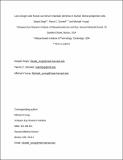Low-oxygen and knock-out serum maintain stemness in human retinal progenitor cells
Author(s)
Singh, Deepti; Dromel, Pierre C.; Young, Michael
Download11033_2020_5248_ReferencePDF.pdf (1.459Mb)
Publisher Policy
Publisher Policy
Article is made available in accordance with the publisher's policy and may be subject to US copyright law. Please refer to the publisher's site for terms of use.
Terms of use
Metadata
Show full item recordAbstract
Using stem and progenitor cells to treat retinal disorders holds great promise. Using defined culture conditions to maintain the desires phenotype is of utmost clinical importance. We cultured human retinal progenitor cells (hRPCs) in different conditions: such as normoxia (20% oxygen), and hypoxia (5% oxygen) with and without knock-out serum replacement (KOSR) to evaluate its effect on these cells. KOSR is known nutrient supplement often used to replace bovine serum for culturing embryonic or pluripotent stem cells, especially those destined for clinical applications. The purpose of this study was to identify the impact of different environmental and chemical cues to determine if this alters the fate of these cells. Our results indicate that cells cultured with or without KOSR do not show significant differences in viability, but that the oxygen tension can significantly change their viability (higher in hypoxia than normoxia). However, cells with KOSR in hypoxia condition expressed significantly higher stemness markers such as C-myc and Oct4 (31.20% and 13.44% respectively) in comparison to hRPCs cultured in KOSR at normoxia (12.07% and 4.05%). Furthermore, levels of markers for retinal commitment such as rhodopsin were significantly lower in the KOSR supplemented cells in hypoxia culture compared to normoxia. KOSR is known to improve proliferation and maintain stemness of embryonic cells and our experiments suggest that hRPCs maintain their proliferation and stemness characteristics in hypoxia with KOSR supplement. Normoxia, however, results in mature cell marker expression, suggesting a profound effect of oxygen tension on these cells.
Date issued
2020-01Department
Massachusetts Institute of Technology. Department of Materials Science and EngineeringJournal
Molecular Biology Reports
Publisher
Springer Science and Business Media LLC
Citation
Singh, Deepti et al. "Low-oxygen and knock-out serum maintain stemness in human retinal progenitor cells." Molecular Biology Reports 47, 3 (January 2020): 1613–1623. © 2020 Springer Nature B.V.
Version: Author's final manuscript
ISSN
0301-4851
1573-4978